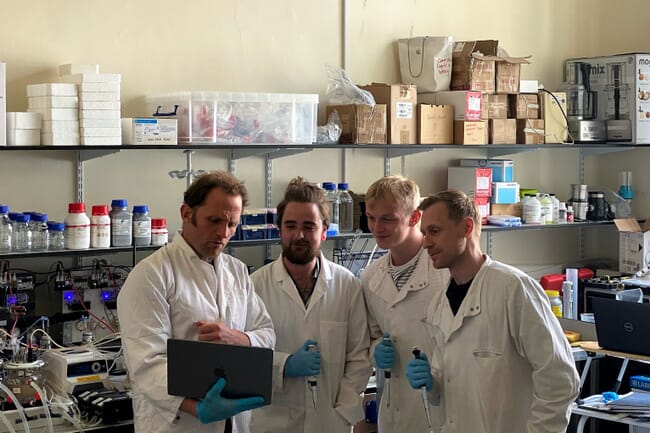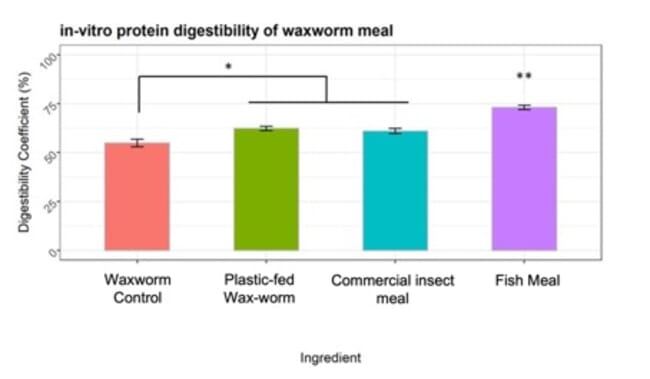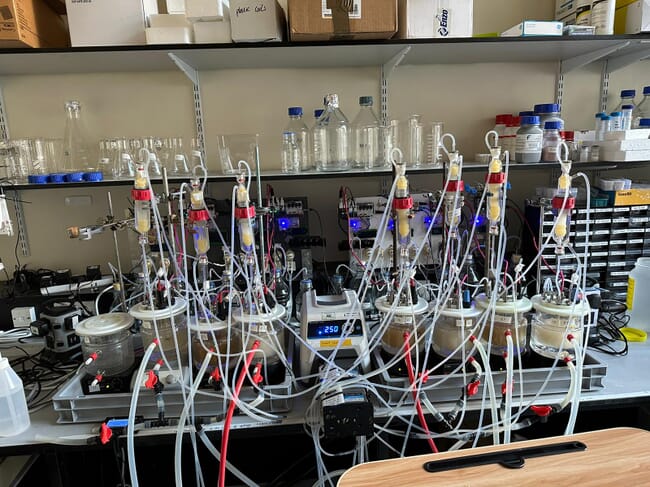
Martin Llewellyn - Professor of molecular ecology at Glasgow University and founding director of SalmoSim - is on the left
While a growing body of evidence suggests that waxworms could help tackle the global plastic pollution crisis, SalmoSim’s findings go a step further – suggesting that protein sources for farmed fish could be derived from insect larvae which have been used to digest plastic waste, thus contributing to the wider circular economy.
Typically farmed salmon feed is made up of 10-50 percent fish meal, which is sourced from wild-caught fish including anchoveta, mackerel and sandeels. The use of wild-caught fish in fishmeal puts huge pressure on marine ecosystems, as well as taking a key source of protein away from coastal communities, particularly those in the Global South, which rely on fish as their main form of protein.
In light of such stressors, there is a pressing need for low-cost, sustainably produced and nutritious alternatives to marine protein to feed farmed fish. These sustainable feeds must be shown to be economically viable and suitable for the fish regarding their digestibility and nutritional value.
SalmoSim is an in-vitro model of the Atlantic salmon’s gut system established in 2016 and based at the University of Glasgow. Originally developed to study the salmon’s gut microbiome, SalmoSim is now deploying a novel assay named “SalmoSim Digest” which predicts the digestibility of alternative ingredients alongside a model for the absorption of nutrients by the fish. Benchmarking of the model against tests on real salmon shows that SalmoSim is 87 percent accurate.
Over recent years, protein-rich insect meal has been found to be a suitable ingredient in the diet of farmed salmon. Performance of farmed salmon was found to be similar to those fed industry standard fish meal as demonstrated by in-vivo trials. However, many insect meals remain costly to produce when compared with other protein sources.
In recent years waxworms have been shown to readily consume polyethylene as part of their diet. Considering that plastic waste is difficult to recycle and poses a burden to the environment, the SalmoSim team tested the hypothesis that waxworms fed low-density polyethylene (LDPE) could be a more accessible source of protein for fish feeds, using its in-vitro simulator of the salmon’s gastrointestinal tract.

Compared to other insect meals, and benchmarked against fish meal, waxworms performed very well and could be an important source of feed for salmon © SalmoSim
As part of the testing process, waxworms were maintained with a diet of either LDPE plastic (cling film) or a traditional balanced diet while waxworm growth was monitored. Waxworms fed LDPE gained weight compared to unfed controls.
A whole waxworm meal powder was produced and subjected to SalmoSim digestibility assay, with digestive phases mimicking the stomach, pyloric caecum, mid-gut and hind-gut of farmed Atlantic salmon. During enzymatic digestion, small nutrients were absorbed from the digesting feed and the amount of absorbed amino acids were determined by spectrophotometric assay.
In-vitro digestibility was calculated by comparison of crude protein concentrations before and after the digestibility assay in a manner mimicking live salmon feeding trials to determine a digestibility coefficient value for each bioreactor digesting the ingredients.
No significant difference in absorbed amino acids was found when comparing the control waxworms with those fed LDPE plastic, indicating their plastic diet did not impact on the waxworm’s concentrations of amino acids digestible by salmon. Interestingly the overall digestibility of plastic-fed worms was slightly higher than those fed on normal feed.
Compared to other insect meals, and benchmarked against fish meal, waxworms performed very well and could be an important source of feed for salmon (Figure 1). Further testing is now required to establish the safety of salmon fed on plastic-fed waxworms.
Commenting on the findings of the SalmoSim study, Martin Llewellyn, Professor of molecular ecology at Glasgow University and founding director of SalmoSim, said in a press release: “We are hugely encouraged by these data which indicate waxworms used to break down plastic could be a potential source of protein for farmed Atlantic salmon. As the pressure on wild fish stocks used for fish meal continues to grow, the need to find alternative, sustainable and low-cost feed stocks for farmed fish has never been greater. While the next step is to ensure that plastic-fed waxworms pose no toxicity to salmon, and can safely enter the human food chain, there is clearly exciting potential here and we look forward to continuing with our research into sustainable protein sources for farmed Atlantic salmon.”





